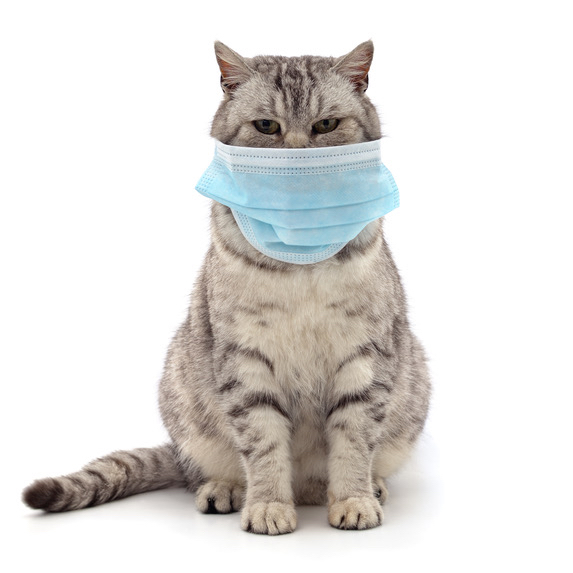Coronaviruses: A Familiar Foe for Veterinarians
Veterinarians are no strangers to the challenges presented by coronaviruses. We deal with a variety of them in small, large and exotic animal medicine. While some of these viruses cause only mild disease and stay at relatively low prevalence within their species, others produce emotional and economic losses similar to what our species is experiencing with the current COVID-19 pandemic. Here is a summary of the most common coronaviruses in veterinary medicine.
Virulent Feline Coronavirus Infection, aka Feline Infectious Peritonitis (FIP)
FIP is a devastating disease affecting domestic and wild cats, particularly young cats from multi-cat homes, catteries and shelters. The large genome size of coronaviruses makes them prone to developing genetic mutations during replication—and it is these genetic mutations that can render feline coronavirus so dangerous. Infection of cats with the avirulent biotype of feline coronavirus is very common and associated with low morbidity. An estimated 80-90% of cats in multi-cat housing situations and up to 50% of cats in single cat homes are infected, and most only develop mild, self-limiting enteritis (diarrhea) followed by seroconversion (immunity). For reasons that are incompletely understood, specific mutations in the viral genome in a small subset (5-10%) of infected cats cause the virus to become virulent. This mutation, possibly in combination with a variation in the host’s humoral immune response, allows the virulent form to replicate in monocytes and macrophages, disseminating the virus and causing systemic inflammation. In addition to presenting a major antemortem diagnostic challenge for small animal veterinarians, FIP carries a poor prognosis for affected cats. There are a variety of potential treatments under active investigation, but no specific treatment yet exists. Treatment is primarily supportive, and depending on the form (effusive vs. non-effusive) and organ systems affected, mean survival times range from a few days to a few months. Luckily, infection is not suspected to result from direct infection with the virulent viral strain after it mutates.
Canine Coronaviruses
Cats aren’t the only companion animals affected by coronaviruses, though FIP generally carries much higher morbidity and mortality than either of the coronaviruses affecting dogs. Canine enteric coronavirus affects the mature cells that line the small intestine and in intestinal lymphoid tissue. Typically clinical signs are non-specific (vomiting, diarrhea, lethargy, hyporexia), though rarely the virus can mutate to a more virulent strain knowns as Pantropic Canine Coronavirus which produces much more severe disease even progressing to neurologic signs and death. Canine Enteric Coronavirus has been isolated from the feces of healthy, aclinical dogs. Vaccines exist but are not considered core vaccines since they provide incomplete protection and clinical signs are most often mild.
The other coronavirus affecting dogs is Canine Respiratory Coronavirus, which is one of many viral pathogens included in Canine Infectious Respiratory Disease Complex (CIRD), more commonly known as kennel cough. Similar to COVID-19 causing the current human pandemic, Canine Respiratory Coronavirus produces symptoms like coughing, sneezing, oculonasal discharge, and the severity of disease it causes is highly dependent on age, immune status and comorbidities. It is passed through respiratory secretions and fomites. It is important to highlight here that currently there is no evidence that dogs (or other companion animals) can contract, get sick from or spread COVID-19.
Swine Enteric Coronavirus Disease (SECD)
Two enteric coronaviruses (porcine epidemic diarrhea virus and porcine deltacoronavirus) produce an enteritis (diarrhea +/- vomiting and anorexia) that results in a staggering 90-100% mortality among infected suckling piglets. For this reason, it has been estimated that the annual economic impact associated with these viruses in the United States is in the range of $900 million to $1.8 billion. In older pigs, clinical signs are more mild, self-limting, and mortality is low. Infected animals begin shedding infectious virus in their feces about 24 hours after they are infected, and the diarrhea begins at the same time or within the next 12 hours.
Ferret Systemic Coronavirus
Causing disease similar to dry FIP in cats, ferret systemic coronavirus also carries a guarded prognosis, though the course of disease tends to be much more slowly progressive. Whereas most cats with FIP survive only a few days past diagnosis, ferrets with ferret systemic coronavirus can live up to 3 years with fluid therapy, nutritional support, symptomatic therapies, and sometimes antibiotics.
The diversity of coronaviruses in animals (including humans) reflects this viral family’s ability to mutate rapidly and to recombine with coronaviruses from other species in order to change in virulence and seek out new hosts. Veterinary virologists are well poised to make major contributions to the management of the current pandemic and the development of a vaccine against COVID-19.
Adapted from information available in the VINcyclopedia of Diseases
